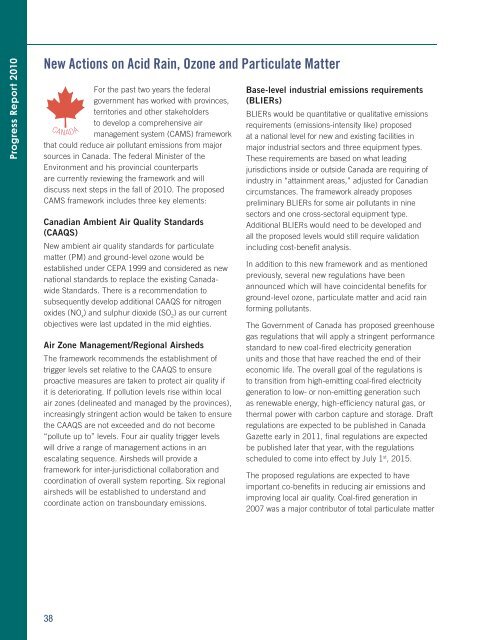2010 Progress Report - International Joint Commission
2010 Progress Report - International Joint Commission
2010 Progress Report - International Joint Commission
You also want an ePaper? Increase the reach of your titles
YUMPU automatically turns print PDFs into web optimized ePapers that Google loves.
<strong>Progress</strong> <strong>Report</strong> <strong>2010</strong><br />
New Actions on Acid Rain, Ozone and Particulate Matter<br />
For the past two years the federal<br />
government has worked with provinces,<br />
territories and other stakeholders<br />
to develop a comprehensive air<br />
management system (CAMS) framework<br />
that could reduce air pollutant emissions from major<br />
sources in Canada. The federal Minister of the<br />
Environment and his provincial counterparts<br />
are currently reviewing the framework and will<br />
discuss next steps in the fall of <strong>2010</strong>. The proposed<br />
CAMS framework includes three key elements:<br />
CANADA<br />
Canadian Ambient Air Quality Standards<br />
(CAAQS)<br />
New ambient air quality standards for particulate<br />
matter (PM) and ground-level ozone would be<br />
established under CEPA 1999 and considered as new<br />
national standards to replace the existing Canadawide<br />
Standards. There is a recommendation to<br />
subsequently develop additional CAAQS for nitrogen<br />
oxides (NO x<br />
) and sulphur dioxide (SO 2<br />
) as our current<br />
objectives were last updated in the mid eighties.<br />
Air Zone Management/Regional Airsheds<br />
The framework recommends the establishment of<br />
trigger levels set relative to the CAAQS to ensure<br />
proactive measures are taken to protect air quality if<br />
it is deteriorating. If pollution levels rise within local<br />
air zones (delineated and managed by the provinces),<br />
increasingly stringent action would be taken to ensure<br />
the CAAQS are not exceeded and do not become<br />
“pollute up to” levels. Four air quality trigger levels<br />
will drive a range of management actions in an<br />
escalating sequence. Airsheds will provide a<br />
framework for inter-jurisdictional collaboration and<br />
coordination of overall system reporting. Six regional<br />
airsheds will be established to understand and<br />
coordinate action on transboundary emissions.<br />
Base-level industrial emissions requirements<br />
(BLIERs)<br />
BLIERs would be quantitative or qualitative emissions<br />
requirements (emissions-intensity like) proposed<br />
at a national level for new and existing facilities in<br />
major industrial sectors and three equipment types.<br />
These requirements are based on what leading<br />
jurisdictions inside or outside Canada are requiring of<br />
industry in “attainment areas,” adjusted for Canadian<br />
circumstances. The framework already proposes<br />
preliminary BLIERs for some air pollutants in nine<br />
sectors and one cross-sectoral equipment type.<br />
Additional BLIERs would need to be developed and<br />
all the proposed levels would still require validation<br />
including cost-benefi t analysis.<br />
In addition to this new framework and as mentioned<br />
previously, several new regulations have been<br />
announced which will have coincidental benefi ts for<br />
ground-level ozone, particulate matter and acid rain<br />
forming pollutants.<br />
The Government of Canada has proposed greenhouse<br />
gas regulations that will apply a stringent performance<br />
standard to new coal-fi red electricity generation<br />
units and those that have reached the end of their<br />
economic life. The overall goal of the regulations is<br />
to transition from high-emitting coal-fi red electricity<br />
generation to low- or non-emitting generation such<br />
as renewable energy, high-effi ciency natural gas, or<br />
thermal power with carbon capture and storage. Draft<br />
regulations are expected to be published in Canada<br />
Gazette early in 2011, fi nal regulations are expected<br />
be published later that year, with the regulations<br />
scheduled to come into effect by July 1 st , 2015.<br />
The proposed regulations are expected to have<br />
important co-benefi ts in reducing air emissions and<br />
improving local air quality. Coal-fi red generation in<br />
2007 was a major contributor of total particulate matter<br />
38
















